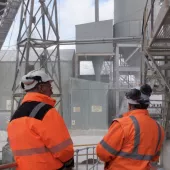British Aggregates Association Conference 2013

First published in the August 2013 issue of Quarry Management as Record turnout at BAA conference
The 2013 conference of the British Aggregates Association (BAA) was held at the Ramside Hall Hotel, Durham, on Monday 24 June and attracted almost 100 attendees – a new record for the organization.
The morning session was chaired by long-serving BAA secretary Peter Huxtable and comprised five short ‘cameo’ presentations on a diverse range of subjects. The opening presentation was given by Martin Layer of Smiths Bletchington, who gave an update on inert waste restoration using the Wallasea Island Wild Coast Project as a fine, if untypical example. He went on to explain the challenges associated with current recovery vs disposal tests and pointed out that although official targets require the amount of inert waste sent to landfill to be halved, in 2010 it actually increased by 27% compared with the previous year. On a different subject, he advised that the Pond Conservation Trust is relaunching as the Freshwater Habitats Trust, and that a new technique of DNA tracking has been developed to identify the presence of newts by analysing water samples, which promises to be much less expensive than traditional survey methods.
The next talk was given by Jim Davies, principal planning officer - Midlands with the Environment Agency, on the theme: ‘The aggregates industry and Environment Agency – working together?’ His wide-ranging presentation covered the role of the Environment Agency (EA) and how it is trying to create a better system of regulation. He went on to refer to legislation that affects the industry, such as the Waste Framework Directive referred to by the previous speaker and also revisions to the Water Act 2003, which will include changes to the arrangements for abstraction licences. It was explained that despite its core role to protect the environment, the EA also fully recognizes the need for economic growth and one of its objectives is to ensure greater consistency of advice from region to region in future.
Phil James, executive director of the Institute of Quarrying/Mineral Products Qualifications Council, gave an eloquent presentation on the concept of ‘Total Professional Development’ via the PRIME Project – a newly created acronym which stands for Professional Recognition In Mineral Extraction. He explained the project’s objective of creating a professional ethos throughout the whole industry by providing a CPD (Continuing Professional Development) scheme for those employed at operative as well as management level in the industry. The new scheme, which has attracted government funding support, is part of the industry’s ‘Target Zero’ accident-reduction programme and is scheduled to be launched at the Hillhead show in June 2014.
Liz Harris, restoration advisor with Nature After Minerals (NAM), gave an update focusing on NAM’s key roles of advising on priority habitats found at mineral sites; working with stakeholders towards strategic landscape objectives; and raising awareness of high-quality mineral restoration. She explained that there was an urgent need to halt the loss of biodiversity and recommended that industry should help deliver targets by letting nature ‘do its thing’ through natural regeneration, instead of conventional managed restoration.
‘Managing rockfall in quarries’ was the title of the presentation given by Thomas Clifford, senior geotechnical engineer with Atkins. He started by explaining that rockfall was the cause of more than half of all rock slope instability incidents worldwide which cause injury or death. He went on to describe the findings of a research project to provide a better understanding of what happens when rocks fall from a quarry face, with reference to face height, face angle and the ‘roughness’ of the face. Also, the project analysed bounce height and roll-out distance, together with the effects of scree and launch features. It was explained that once these factors could be measured, quarry development plans could be designed to maximize the potential for extraction while still providing a safe working environment for employees.
The morning session concluded with the BAA’s Assessment of Operating Standards ceremony, at which representatives of Tillicoultry Quarries, Raymond Brown Group,
Middleton Aggregates, Henry Streeter and Huntsmans Quarries received their certificates from well-known former HSE Inspector Eric Darlow. In his speech, Mr Darlow made reference to the excellent value for money offered by the scheme and reminded delegates that companies requiring attention from HSE to deal with any shortcomings in safety systems at their quarry sites will now be getting a bill for the inspector’s time, which is being charged at £124 per hour.
Staying with the health and safety theme, the opening address of the afternoon session was given by David Gartside, HSE board member and former vice-president of safety, health and environment with Astra Zeneca. He started by making the point that the UK has one of the best health and safety systems in the world with workplace accidents remaining on a decreasing trend. He went on to say, however, that although the aggregates industry has reduced its accident rate by 76% over the past decade, the fatality rate is still more than 20 times the average for all industries. He explained that slips, trips and falls, both high and low, accounted for almost half of all accidents, with moving machinery and asphyxiation as a result of being pulled into mobile crushing plant being the two main causes of fatalities in the industry. He noted that the majority of incidents were associated with poor risk control, insufficient levels of competence and/or inadequate supervision. And, as in other industries, he felt that leadership, competence and workforce participation would be the key to driving down accident rates.
Representing academia, Mark Osbaldeston, head of the Centre for Mineral Products Professional Development at the University of Derby Corporate, gave an overview of the wide range of programmes now available from the team based at the new Enterprise Centre in the centre of Derby. He reminded delegates that this provision started when the former DAPS courses in Quarry and Asphalt Technology moved from Doncaster College to the University in 2007. Since then courses had been developed for the concrete and clay products sectors, and the most recent developments were the launch of a Higher Apprenticeship programme for school leavers and a new modular Honours Degree for Extractives.
In keeping with the optimistic view of the future, as seen by the University, Andy Sales of market research specialists BDS Marketing gave an encouraging presentation on the trends and opportunities that are foreseen within the sector over the next five years. In noting that the industry had experienced a fall in volumes of around 40% in the past five years, BDS now envisages that demand for aggregates will grow steadily for three years driven by an increase in construction output.
The proceedings concluded with a presentation by Peter Barkwill, managing director of John Wainwright & Co. Ltd, who explained how recession, hardships and challenges can be the fuel of growth and opportunity. The story, delivered in a very personal and engaging manner, explained how, despite the general downturn in the market, a private operator in the Mendips has been able to grow its business by winning market share from competitors. Mr Barkwill said that since 2008, Wainwright had enjoyed the best five years in their 121-year history by empowering staff, ‘fostering the dynamic’ and growing the business for the benefit of all. In conclusion, he stated that by focusing on efficiency of production, loving your staff and making the customer your king – success will come your way.
- Subscribe to Quarry Management, the monthly journal for the mineral products industry, to read articles before they appear on Agg-Net






